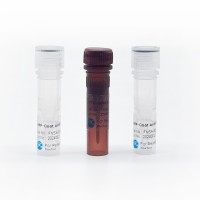The central nervous system (CNS) of the third instar larva is a tissue of choice for studying conventional mitotic cycles in Drosophila . For example, squash preparations of the larval CNS are routinely used to investigate chromosome structural and numerical anomalies in late larval lethal mutants (e.g., refs. 1 ,2 ; also see Chapters 16 –18 ), to study heterochromatin (e.g., refs. 3 –5 ), and to localize chromosomal proteins by immunostaining (see Chapter 19 ). Mitotic chromosomes are not unduly harmed upon squashing, and for many experimental purposes it is advantageous to have them flat and well spread. However, the same cannot be said of the mitotic spindle, which is distorted or destroyed in squash preparations. A simple method for live analysis of mitosis in larval brain cells involves “pulverizing” dissected brain tissue with fine scalpel blades to produce a monolayer of cells for short-term (approx 1 h) study (6 ). The method can be used to visualize any mitotic proteins/structures for which green fluorescent protein (GFP)-expressing strains are available, and both wild type and mutants can be studied with equal facility. However, a potential drawback is that both the mechanical disrupting of tissue and nonphysiological culture medium used could have adverse effects on mitosis. Moreover, information about relative spindle geometry in a developmental context (e.g., ref. 7 ) is lost. A complementary approach to the above methods is to use whole-mount preparations of fixed brains to obtain a three-dimensional (albeit static) view of mitosis.






